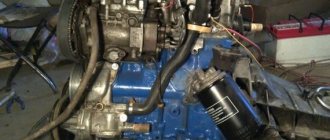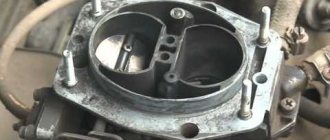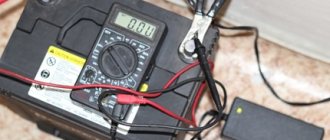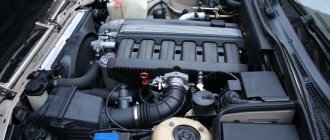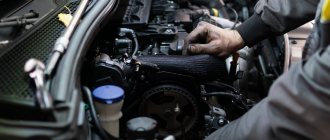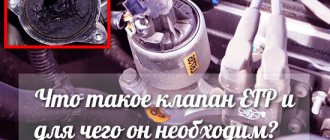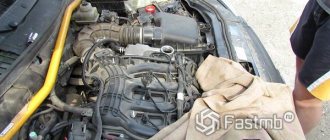Symptoms
It is not difficult to recognize the problem - when the engine is running, sharp twitching (“sobs”) appear, the speed decreases, the smell of unburnt gasoline in the combustion chamber appears, and strong vibrations are transmitted to the steering wheel.
As the engine warms up, the above symptoms may disappear, and the engine begins to run smoothly, without failures. But even in this case, it is advisable not to start the problem.
What happens if the problem is not fixed?
Since this phenomenon occurs when it is cold, and when it warms up the problem is no longer noticeable. Therefore, many drivers, not wanting to spend money on repairs, simply do not pay attention, believing that the problem is not serious.
We do not recommend doing this! Ignoring it will lead to more serious consequences. The air-fuel mixture does not burn completely and accumulates on the cylinder, which in turn becomes covered with soot.
The performance of the motor when tripling is reduced. Compression begins to drop, engine speeds fluctuate, fuel consumption increases, acceleration dynamics are weak, wear on the piston rings increases, and the inner walls of the cylinder begin to be damaged. The cylinder block may need to be lined or bored.
Ultimately, without making timely repairs, thinking to save money, you will spend much more money on major repairs or on replacing the power unit.
Injection engine
Engines with injection are a real mystery for many car enthusiasts, because they are electronics – a “black box”.
Sometimes you can even hear the opinion that if the engine is misfiring on a fuel-injected car, then you need to immediately take the equipment to a service station.
But a competent car enthusiast can still perform some activities on his own.
The main reason
This is a lack of spark in one of the spark plugs. In such a situation, further troubleshooting is very confusing - you have to check coils, switches, sensors and even the car's ECU.
And here it is really difficult to cope on your own - you need to go for computer diagnostics to specialists in their field.
Injector malfunction
If there is a spark, the second most likely cause of failure may be the injector. It is not difficult to identify such a malfunction. With the engine running, it is necessary to disconnect the chips from the injectors one by one.
The task is to find one whose disabling will not lead to changes. Try swapping injectors.
If a cylinder with a “faulty” injector works normally, then the fault will have to be looked for elsewhere.
Fuel pump malfunctions
There is an opinion that the engine may stall due to a faulty fuel pump. But in this case, the problem will alternately “creep out” on all cylinders (and not specifically on one).
Moreover, if the fuel pump malfunctions, the engine may not start at all. In this situation, the only way is to send the car to an electrician for diagnostics.
Air flow sensor
Another probable cause is a malfunction of the air flow sensor.
Of course, you can detect the main faults yourself, but there are also some that only a specialist can help identify.
Carburetor engine
In the case of a carburetor engine, the first thing you need to pay attention to is the quality of the spark plugs. If one of them malfunctions, then the engine almost always runs cold.
Therefore, candles need to be chosen correctly, more details here.
It is not difficult to identify such a problem - you need to remove the high-voltage wires one by one with the engine running. When you remove the wire from a working spark plug, the engine will stall, but with a faulty spark plug, it will continue to “triple”.
Once the problematic spark plug is found, you need to unscrew it and evaluate the condition of the tip. If it is literally completely soaked in gasoline, then this may indicate that the mixture is too rich or the spark plug has failed.
Breakdown in high-voltage wires
Less frequently, the engine stalls at idle due to a breakdown in high-voltage wires. But this problem is also completely solvable. It is best to check the serviceability of high-voltage wires in the dark - this way you will see sparks that will pass out. In this case, the engine must be running. But this method does not always help. It happens that the breakdown occurs not in the winding, but inside it, that is, the wires themselves are damaged. In this case, take a multimeter and measure the nominal resistance. Ideally, it should be no more than 20 kOhm. If you notice sparks or changes in resistance levels, replace the high-voltage wires with new ones. But remember that their lengths are different. Therefore, before purchasing, remember their length so as not to buy very short or long ones.
Diesel engine
If a cold diesel engine stalls, then there are also plenty of options:
- firstly, the compression in the engine may be too low (or completely absent). Everything here is trivial - the required temperature for ignition of the fuel is simply not reached in the cylinder;
- secondly, the injector may fail, which will supply a stream of fuel into the cylinder without signs of atomization. Here the cause may be a breakdown of the nozzles themselves (in this case, the only way to escape is by replacement);
- thirdly, a malfunction or incorrect operation of the fuel pump is also one of the likely reasons that a diesel engine is not working;
- fourthly, incorrect engine assembly and incorrectly set ignition;
- fifthly, the fuel supply pipes have been swapped;
- sixthly, failure of spark plugs and so on.
Diagnosis of uneven operation in cold conditions
The main problem in troubleshooting is that the engine can stall for a short time. This moment needs to be caught and the reason found. This is especially true when the car is checked at a car service center. The car needs to be left overnight so that the diagnosticians can look at it when it’s cold. Otherwise, when it’s hot, when the engine is running normally, it will be difficult to find the cause.
Engine mechanics
First of all, you need to measure the compression on a cold engine. The indicator should not differ from the standard value for this type of motor. As a rule, for common naturally aspirated gasoline engines, 12-13 atm is considered the norm. If the indicator differs by 1-2 atm, you should think about a problem in the engine mechanics itself.
If the difference in compression is no more than 1-2 atm, you need to measure the thermal clearances of the valves and manually adjust the gas distribution mechanism (GRM).
If the design provides for automatic adjustment using hydraulic compensators, pay attention to the knocking sound from the valve mechanism. If the sound disappears while warming up, remove the hydraulic compensators and check their functionality.
The initial check of the hydraulics is carried out on the engine, with the valve cover removed. Without removing the camshaft, placing the cams in the upper position so that the valve does not put pressure on the hydraulic compensator. It shouldn't be pressed. Otherwise, replace or wash.
In case of low compression, check with oil, if the indicator increases, it’s all a matter of the piston group. If there is a slight increase in compression, repair the cylinder head. When oil gets on leaking piston rings, it closes the micron gaps and the pressure increases.
One type of mechanical damage is a broken cylinder head gasket. Depending on where the gasket burns out, coolant will leak out, get into the oil, oil will leak out, or get back into the antifreeze. If it breaks between the cylinders, compression will be lost.
The most expensive problem is a crack in the cylinder head and short block. Difficult to detect and expensive to eliminate. Metal expands and contracts depending on temperature, so the engine can start running when it’s cold.
A problem with engine mechanics is the most common cause of stalling when cold.
Injector condition when cold
The second and very significant problem of modern engines is the quality of the fuel that we fill every day at gas stations. The disadvantages are not even the quality of the gasoline itself, but the presence of water and condensate. Moisture enters the filling tanks underground from groundwater, rain and is formed due to condensation. It comes in huge quantities. When the pump takes in gasoline, it captures and pumps it all into our tanks. What to do in such a situation.
It is necessary to constantly carry out preventive maintenance of the fuel system: washing the injectors every 30,000 km and pouring pure alcohol into the tank in the amount of 350-500 grams per 20-30 liters of gasoline.
On a cold engine, a dirty injector does not provide the correct spray and volume of fuel into the combustion chamber. Accordingly, the fuel-air mixture violates its proportions and does not ignite. The injector system cannot cope, and as a result the engine starts to stall. As it warms up, the water in the injector nozzle leaves and the engine runs smoothly.
Air leaks
A common type of malfunction when cold. The rubber bands on the injectors and the intake manifold gaskets compress with cold and allow excess air to pass through, which leads to a violation of the stoichiometric composition of the mixture. It is practically impossible to ignite such a mixture, since there is a sharp increase in the volume of oxygen molecules. And, as we know from physics courses, it is very difficult to spark a spark through these molecules.
You need to check the air supply with a smoke generator. Diagnosticians at car repair shops have them. You can make a homemade device from plastic bottles and cigarettes. There is a lot of information on the Internet. You need to check air leaks when the engine is cold.
Mostly, leaks occur through the injector seals, which are located in the cylinder head itself, or in the intake manifold. There are old diagnostic methods using a soap solution, but it is very erroneous. But for lack of anything, this is a good help.
The second place in the rating of leaks is the gasket between the intake manifold and the cylinder head. You can also spill liquid in this area and replace the gaskets if air bubbles appear. The smoke generator is an accurate diagnostic tool.
There are times when the collector cracks inside and it is very difficult to find such a crack.
A common place for leaks in the intake system is the adsorber purge circuit. The so-called tank purging. The hoses, the filter itself, and the valve have rubber seals, which over time crack, collapse, soften and allow excess air into the system. To exclude this cause, you can temporarily plug the canister purge system fitting on the intake receiver and observe.
This system is an environmental norm. In this regard, completely removing the hose from the tank is a violation of environmental standards!
Cold ignition system
Here the main secret lies in the coil, the ignition module. The primary circuit and housing play depending on the temperature and begins to spark when cold. There are times when the car does not want to start at all, since at this moment the primary circuit is closed and there is no sparking.
Thermal expansion also occurs at the point of contact between the spark plugs and the end of the high-voltage wire. When the metal expands, the contact expands so much that the spark hits the side of the engine mass without entering the combustion chamber. The fuel-air mixture will not ignite and the engine will stall when started in the morning.
Problems with the electronic control system
One of the most striking examples of a floating fault when cold is a domestically produced VAZ car of the Kalina brand. The control unit is located in the console under the stove hose, from which coolant constantly drips. The whole problem is in the clamp that clamps the heater hose. To tighten it, you need to disassemble the entire panel. This is an expensive operation and you won’t always immediately find what the problem is. On these vehicles, the ECU must be immediately moved to another location. Even a slight contact of antifreeze on the control unit circuit disables it. The tracks begin to close, the pulses to the coil or injectors disappear. The problem may go away as it warms up.
If the tracks and microcircuits of the electronic control unit are defective or outdated, the engine can start on any car when cold. Also, minor problems with contacts can manifest themselves in the motor harness.
The problem of plastic expansion also exists in control system sensors. This is especially true for resistive elements. This unit includes an absolute pressure sensor in the receiver, which provides a signal for the duration of opening of gasoline injectors. The fuel mixture is prepared depending on the vacuum reading in the intake manifold. If there is a violation in the mechanical part of the sensor, the pressure values will be incorrect and the mixture will be either rich or lean. There will be no ignition in the cylinder and the engine will stall. As the sensor warms up, the operation of the sensor is restored and the engine runs smoothly. The contacts in the connector also play an important role.
Fuel system cold
Signs of water in the tank, fuel pump, lines and injectors are especially noticeable in the winter when the engine is cold. Drops of water freeze, the engine stalls or does not start. You need to check the fuel pressure when it is cold. The value varies from 3 - 4 ATM depending on the type of motor. If the fuel pressure regulator is located in the tank, then the value is usually 4 atm. With low pressure, the engine will stall when cold. After the ice dissolves as it warms up, the pressure in the ramp becomes normal.
As already mentioned, in order to avoid such a malfunction, you need to do moisture prevention. There are special dehumidifiers and water displacers on the counters. For example, you can take any, the main thing is that it contains concentrated alcohol. It mixes with water and exits through the exhaust system. Does not cause detonation or influence on mechanical parts of the engine.
Problem solving
We have already partially examined the reasons that the engine is tripping, and briefly reviewed methods for troubleshooting. Now let's talk about this in more detail.
For a more detailed analysis, it would be a good idea to resort to self-diagnosis. This is very easy to do using an auto scanner.
However, manually searching for a faulty sensor, a problematic spark plug or any other reason, of which, as we have found out, there are many, is not the easiest task.
Considering the low cost of this type of device, it will clearly not be superfluous.
For example, you can use an inexpensive multi-brand Rokodil ScanX scanner.
Rokodil ScanX
This car scanner is compatible with most petrol and diesel cars from 1993 onwards.
All you need to do is connect the device to the ODB2 connector and run diagnostics on your phone, tablet or laptop.
After diagnosis, you will be shown an error code and its description. Next, first of all, you should pay close attention to the problematic sensor.
If the spark plug is faulty
If the diagnostics showed a malfunction of any spark plug, then there are two options:
- Cleaning the electrode;
- Or replacing the spark plug.
The best choice for a car enthusiast is to make a replacement, but if you have free time, you can remove the existing carbon deposits or “smoking.”
By the way, there are many reasons for the appearance of carbon deposits - failure of injectors, overheating of the engine, and malfunction of valves.
In general, there are many options. We have already discussed how to identify a faulty spark plug in the article.

